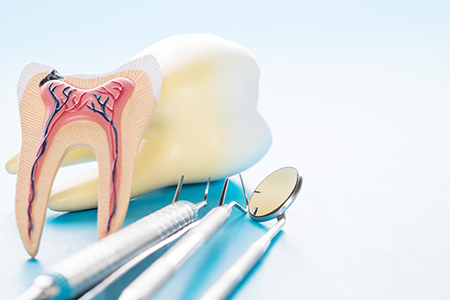New Patients
Existing Patients
New Patients
Existing Patients
New Patients
Existing Patients
New Patients
Existing Patients
New Patients
Existing Patients
New Patients
Existing Patients
New Patients
Existing Patients
New Patients
Existing Patients

If a dentist tells you a tooth needs a root canal, take a breath — it’s not as daunting as it sounds. Modern root canal therapy is a precise, reliable treatment designed to relieve severe tooth pain, eliminate infection, and keep your natural tooth intact whenever possible. For many patients, having a root canal prevents the need for extraction and helps preserve the appearance and function of the smile.
At the office of Artistic Family Dental, we pair up-to-date techniques with a calm, patient-centered approach. Our goal is to make the experience predictable and comfortable while protecting your long-term oral health. Below, you’ll find clear, practical information about why root canals are performed, what to expect, and how timely care supports better outcomes.
Keeping a natural tooth whenever possible has clear benefits. A preserved tooth maintains proper chewing efficiency, supports the surrounding teeth, and helps preserve the jawbone beneath it. Root canal therapy removes the damaged or infected inner tissues while leaving the outer structure in place, giving the tooth a strong chance to function normally for many years.
When a tooth is lost, even a single gap can lead to shifting of neighboring teeth, changes in bite alignment, and increased stress on adjacent teeth. Restorations like crowns and bridges can replace missing teeth, but they don’t always replicate the long-term stability and natural feel of a tooth that was saved. Root canal treatment is often the most conservative way to restore health and maintain a natural-looking smile.
Success rates for modern root canal therapy are high when performed with proper diagnosis and technique. Advances in instrumentation, imaging, and materials have improved predictability. The decision to proceed with treatment balances the tooth’s structural condition, the extent of infection, and the overall restorative plan — all assessed with your long-term oral health goals in mind.

Underneath the hard enamel and dentin lies the dental pulp, a soft collection of nerves, blood vessels, and connective tissue. When cavities, cracks, or trauma expose or irritate that inner tissue, bacteria can invade and inflame the pulp. That inflammation often produces persistent, throbbing pain or heightened sensitivity that does not resolve on its own.
In some cases the pulp becomes irreversibly damaged or dies, leaving the root canal system vulnerable to bacterial growth and the formation of an abscess at the tooth’s root. Symptoms can include lingering sensitivity to hot or cold, pain when biting, visible darkening of a tooth, swelling around the gum, or even mobility if surrounding bone becomes affected. Not every symptom points to a need for a root canal, but these signs warrant a focused evaluation.
Diagnostic tools such as a careful clinical exam and targeted X-rays help determine the source of pain and the extent of any infection. When the pulp is compromised but the surrounding tooth structure and bone are otherwise favorable, root canal therapy provides a predictable path to healing without removing the tooth.
Delaying care can allow an infection to deepen and spread, increasing the chance of more extensive damage to the tooth and surrounding tissues. Early intervention often means a simpler procedure, less post-treatment discomfort, and a better prognosis for long-term retention of the tooth. Regular dental exams also catch some issues before symptoms develop, allowing treatment at a less urgent stage.
A tooth that looks or feels only mildly different can still harbor developing problems that show up on X-rays. When a root canal is recommended, it’s usually because the risk of leaving the tooth untreated outweighs the short-term inconvenience of treatment. Timely care reduces the likelihood of complications and supports more straightforward restorations afterward.
Your dentist will factor in overall oral health, the amount of remaining tooth structure, and restorative plans when advising on treatment timing. Acting on professional recommendations helps protect neighboring teeth, maintain bite function, and minimize the need for more invasive procedures later on.
Root canal treatment is a focused, stepwise process carried out under local anesthesia, so most patients feel minimal discomfort during the procedure. The tooth is isolated, an access is created to reach the pulp chamber, and the diseased tissue is removed. The canals are then shaped, disinfected, and filled with a biocompatible material to seal the space and prevent reinfection.
Procedure length varies by tooth complexity and whether infection is present. Some teeth can be treated in a single visit; others may require two visits if an active infection needs time to clear. Throughout, the goal is effective disinfection and a durable seal — essential elements that determine long-term success.
After the internal work is completed, the tooth is restored to restore strength and function. Many teeth benefit from a protective crown or similar restoration to prevent fracture and to re-establish reliable biting surfaces. Your dentist will explain the recommended restoration and the expected timeline for completing that phase of care.

Following treatment, mild tenderness or sensitivity for a few days is common as the surrounding tissues recover. Over-the-counter pain relievers and short-term adjustments in chewing habits typically manage these symptoms. If stronger pain or swelling develops after treatment, contact the office promptly to ensure appropriate follow-up care.
A treated tooth remains more brittle than an untreated tooth until it is fully restored. That’s why placing a permanent crown or durable restoration in a timely manner is an important step to protect the tooth from fracture. In the interim, avoid chewing hard or sticky foods on the treated side and follow any temporary-care instructions provided by your dentist.
Good home care — regular brushing, flossing, and routine dental visits — supports the long-term health of a tooth that has undergone root canal therapy. With appropriate restoration and maintenance, many root canal-treated teeth remain functional for the rest of a patient’s life.

At Artistic Family Dental, we aim to guide patients through each step with clear explanations and compassionate care. If you’re experiencing symptoms described above or have concerns about a particular tooth, an examination and diagnostic imaging can clarify whether root canal therapy or another treatment is the best option for you.
In summary, root canal therapy is a well-established procedure that relieves pain, eliminates infection, and helps preserve natural teeth when the internal tissues are compromised. Timely diagnosis, modern techniques, and appropriate restoration afterward are the foundations of a predictable outcome.
For more information about root canal treatment or to discuss a specific concern, please contact us for assistance and to arrange an evaluation.

A root canal procedure is the best way to save a tooth that has been damaged by decay or injury and preserve your natural smile. The alternative is an extraction and treatment to replace the tooth. While at times a tooth is non-restorable and an extraction is the only option, when possible, it’s best to try and save your natural tooth. With proper care, a tooth with root canal therapy can serve your smile well for many years to come.
Despite lingering myths from before the age of modern dental anesthesia and technology, having a root canal procedure today is as routine and comfortable as visiting the dentist for a filling. While the procedure is performed under local anesthesia with your tooth completely numbed, we can also discuss options in dental sedation.
Whether the symptoms of a dental infection subside after a course of antibiotics, a draining abscess provides you with some temporary pain relief, or a tooth with radiographic evidence of pathology has not yet developed symptoms, it’s essential, before an infection worsens or occurs, to have a root canal procedure performed. In this way, the tooth can be disinfected, filled, and sealed to protect your health and avoid further problems.
If you have sustained a dental injury, have a toothache, jaw pain, swelling, or are experiencing any other unusual and uncomfortable oral symptoms, contact our office immediately for care. Dental problems that have not been evaluated and treated can significantly worsen, producing more severe damage and consequences for the involved teeth, your oral health, and even your overall wellbeing. Once you get in touch with our office, our friendly and compassionate office team will get you in for care at your earliest convenience.
While some root canal procedures can be completed in one visit, others may involve 2 or 3 appointments. How long it takes depends on various factors, including active infection, the number of canals in the tooth, and the tooth’s location or anatomy.
With a success rate that exceeds 95%, root canal therapy remains the most effective procedure to save a tooth in which the inner vital tissues have been damaged. However, as with all healthcare procedures, there are a small percentage of cases where the teeth become symptomatic a second time. The good news is that many of these teeth can still be saved with root canal retreatment or a minor surgical procedure known as an apicoectomy.
The best ways to maintain a tooth with root canal therapy are to get the proper restoration required to rebuild and protect the tooth, maintain proper oral hygiene, and schedule appointments for routine dental checkups and care.
Saving a tooth with root canal therapy is a wise investment that, in the long run, is typically less costly and invasive than having the tooth extracted and replaced with a fixed bridge or implant. As far as the exact cost of care, it can vary depending on which tooth is being treated. Many dental insurance plans provide coverage for root canal therapy. At the office of Artistic Family Dental, we do our best to optimize your dental benefits and minimize your out-of-pocket expenses. Our staff will answer all your questions about the cost of care and discuss all your payment options.
At the office of Artistic Family Dental, we use the latest technology and most effective methods of care to provide precise and gentle care. Our reputation for excellence is based upon a consistent record of achieving successful treatment outcomes while providing prompt, stress-free, and convenient treatment for every type of dental need.
Root canal therapy is a dental procedure that removes damaged or infected pulp from inside a tooth and seals the space to prevent reinfection. The pulp contains nerves and blood vessels that can become inflamed from deep decay, cracks, or trauma. By cleaning and filling the canals within the roots, the tooth can often be preserved instead of being extracted.
The goal of the treatment is to relieve pain, eliminate infection, and restore the tooth's ability to function normally. Modern techniques and local anesthesia make the procedure predictable and comfortable for most patients. At Artistic Family Dental we focus on clear communication and gentle care to guide patients through each step.
Your dentist may recommend a root canal when the pulp is infected, irreversibly inflamed, or has died, and saving the natural tooth is the best option. Symptoms that prompt this recommendation can include persistent toothache, prolonged sensitivity to hot or cold, pain when biting, swelling, or a darkened tooth. Diagnostic tools such as clinical exams and targeted X-rays help determine the extent of the problem.
The recommendation balances the tooth's structural condition, the presence of infection, and the overall restorative plan for long-term oral health. When feasible, preserving a natural tooth helps maintain proper chewing, prevents neighboring teeth from shifting, and preserves underlying bone. Prompt treatment typically improves prognosis and reduces the need for more invasive care.
Bacteria reach the inner pulp when protective layers such as enamel and dentin are breached by deep decay, cracks, or dental trauma. Once bacteria enter the pulp chamber they can cause inflammation, severe pain, and eventually tissue death, which allows infection to spread through the root canal system. An untreated infection can form an abscess and affect surrounding bone and gum tissues.
Not every cavity or sensitivity means the pulp is compromised, but persistent symptoms or radiographic signs of infection warrant focused evaluation. A careful clinical exam and imaging clarify whether the pulp can be saved with treatment or whether alternative interventions are needed. Early detection limits damage and often simplifies subsequent care.
Root canal therapy begins with local anesthesia and isolation of the tooth to ensure patient comfort and a dry working field. The dentist creates a small access opening to reach the pulp chamber, then removes diseased tissue and carefully cleans and shapes the canals using specialized instruments. The canals are disinfected and filled with a biocompatible material that seals the space and helps prevent reinfection.
Procedure time varies by tooth complexity and the presence of infection, and some cases require multiple visits to fully control inflammation. After the internal work is complete, the tooth is temporarily restored and later fitted with a permanent restoration, often a crown, to restore strength and function. The dentist will explain the expected timeline and any necessary follow-up steps.
Modern root canal treatment is performed under local anesthesia, so most patients experience minimal discomfort during the procedure. Any discomfort before treatment is usually due to the underlying infection or inflammation, and relieving that source of pain is a primary goal of the therapy. Sedation options may be available for patients with anxiety to increase comfort and reduce stress during the visit.
Mild tenderness or sensitivity after the procedure is common for a few days as surrounding tissues heal, and it is typically managed with over-the-counter pain relievers and short-term adjustments in chewing. If you experience increasing pain, swelling, or fever after treatment, contact the dental office promptly for evaluation and follow-up. Proper post-treatment care and timely restoration reduce the risk of complications.
Preparation for a root canal is straightforward and mainly involves practical planning rather than special medical steps. Eat a light meal unless otherwise advised, bring a list of current medications and medical conditions, and arrange transportation if you plan to use sedation beyond local anesthesia. If you have a history of complicated medical conditions, inform the dentist so appropriate precautions can be taken.
Ask questions beforehand about the expected length of the appointment, post-treatment instructions, and the timeline for any needed permanent restoration. Understanding the process and having realistic expectations helps reduce anxiety and ensures a smoother experience. Following any pre-appointment guidance from your dental team supports a safe and efficient visit.
After root canal therapy you can expect mild soreness or sensitivity for several days as the tissues heal, and normal daily activities can usually be resumed the same day. Avoid chewing hard or sticky foods on the treated side until the tooth has its permanent restoration to prevent fracture. Maintain good oral hygiene with gentle brushing and flossing and follow any temporary-care instructions provided by your dentist.
Complete restoration, often with a crown, is important to protect the treated tooth and restore full function, so schedule that follow-up in a timely manner. Routine dental checkups and regular hygiene visits help monitor the tooth and detect any signs of recurring infection early. With proper restoration and home care, many treated teeth remain functional for many years.
Teeth that have undergone root canal therapy are often more brittle because the inner tissues have been removed and the tooth structure may be weakened by decay or previous restorations. A crown provides a protective cap that distributes biting forces, reduces the risk of fracture, and restores a reliable chewing surface. The type of restoration recommended depends on the tooth's location, remaining structure, and functional demands.
Placing a permanent crown or other durable restoration also helps seal the coronal portion of the tooth and supports long-term success by preventing reinfection. Your dentist will explain the recommended material and timeline based on the tooth's condition and your overall treatment plan. Timely restoration is a critical step in maintaining the treated tooth's longevity.
Alternatives to root canal therapy depend on the tooth's condition and your overall oral health goals, and they may include extraction with replacement using a bridge, denture, or dental implant. Each alternative has different implications for function, neighboring teeth, and bone preservation, so the decision should consider long-term consequences and restorative needs. In early cases, sometimes pulpotomy or other less invasive pulp treatments can be appropriate, particularly in specific clinical situations.
Your dentist will review the pros and cons of each option, including the expected functional outcomes and required follow-up care. The choice often reflects the amount of remaining tooth structure, the presence of infection, and your preferences for preserving natural teeth. Shared decision-making ensures the selected approach aligns with your oral health priorities.
With proper restoration and regular dental care, a root canal-treated tooth can last many years and often remains functional for a lifetime. Long-term success is influenced by factors such as the quality of the endodontic procedure, the type and timing of the final restoration, bite forces, and ongoing oral hygiene. Regular examinations and timely attention to new symptoms help protect the tooth and address issues early if they arise.
If a treated tooth shows signs of renewed infection, fracture, or persistent symptoms, retreatment or surgical options may be considered to preserve the tooth. Discussing realistic expectations and a maintenance plan with your dentist supports the best possible outcome. If you have questions about a specific tooth or need an evaluation, the team at Artistic Family Dental can provide a thorough assessment and treatment recommendations.

Ready to schedule your next appointment or learn more about our services?
Our friendly team is here to make it easy. Whether you’d like to call, email, or use our convenient online form, we’ll help you find the right time and answer any questions you have. Don’t wait to take the next step toward a healthier, more confident smile—contact Artistic Family Dental today and experience the difference genuine, personalized care can make.